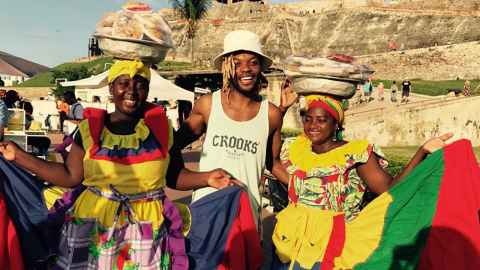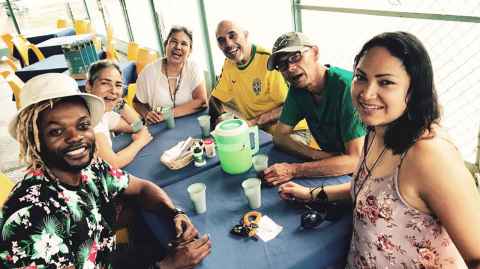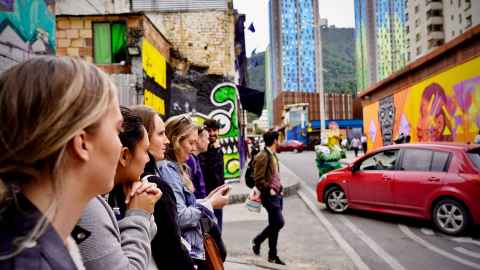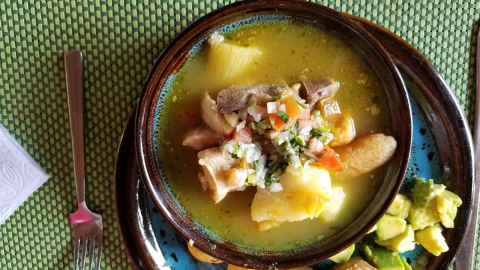Champeta, canelazo and conversation in Colombia
21 February 2020
A conversation about peace in Spanish during a late-night taxi ride across Bogotá was a highlight for University of Auckland student Redelond Tsounga during a recent trip to Colombia.

Redelond was one of a group of 20 Faculty of Arts students who spent four weeks in the South American country last November on a Prime Minister’s Scholarship for Latin America.
Based at the University of Los Andes (Universidad de los Andes) in Bogotá, the group, who were mostly masters students in Conflict and Terrorism Studies, were there to learn about the conflict and peace process in the country which is only just recovering from five decades of civil war.
The taxi ride came during a week of intense protests against various economic and political reforms proposed by the government of Iván Duque Márquez, and Redelond says tensions were running high and a curfew had been placed on the city.
“After saying goodbye to my new Colombian friend Marce in the west of Bogotá, I caught a taxi back to my apartment and the taxi driver, a man of around 55 or 60, didn’t speak a word of English so I was compelled to only speak Spanish,” he says.
“Surprisingly, I became very fluent that night and we were able to talk about the Colombian political situation entirely in Spanish. He was hopeful that peace would come to Colombia and that things would get better.”
To understand as much as he could, Redelond went to Giradot, two hours south of Bogotá, to interview two members of the Guzman family, Umberto Acosta and Ivan Gonzales, brothers-in-law who held opposing views on the peace agreement.
“It was great to get a locals’ perspective which sat outside theoretical frameworks and literature. I was able to put into practice my anthropological knowledge on conducting an ethnography, and as American anthropologist Clifford Geertz has said, the best way to study people is to speak to them personally so you can see things through their eyes. The polarisation in the Guzman family mirrored the divide in the country.”

After the interview, Ivan surprised Redelond with a t-shirt worn during the peace plebescite (non-binding referendum) which says ‘Por la Paz’ ('I vote for peace'). He also gave him a book about the Colombian conflict to which he had contributed a few chapters. “In return, I gave him one of my motivational t-shirts which says ‘Never ever give up’," he says.
After four years of negotiations, in 2016 negotiators hammered out a 300-page peace document signed by Colombian officials and left wing rebel movement FARC (Revolutionary Armed Forces of Colombia). It was intended to end the 50-year conflict between the government, FARC and various right-wing paramilitary groups and narco cartels that had claimed an estimated 260,000 lives and displaced around seven million people.
Some critics argued that by granting amnesty to FARC, the agreement secured peace at the expense of justice and that FARC members would not be suitably punished for their many crimes. However, Redelond says recent protests have been in support of FARC and against the deeply unpopular government, which aside from proposing a cut to pensions, has also been accused of doing very little to protect Indigenous community leaders who are being murdered in high numbers in what appear to be politically motivated crimes.

As well as attending daily lectures, the University group, which included masters course co-convenors Drs Chris Wilson and Tom Gregory, were also keen to have a rich social and cultural experience, immersing themselves in the vibrant life of the city and taking a side trip to the colonial port of Cartagena on the Caribbean coast.
In Cartagena, they attended a presentation by a member of the ‘Ruta Pacifica de Las Mujeres’ (a feminist peace movement) who talked about the particular challenges faced by women as a result of the long conflict and their fight towards empowerment. They also visited the Centro de Cultura Afro-Carribe, a non-profit organisation that provides education for around 150 children in a poor part of the city.
“In Colombia there is a vast contrast between the rich and the poor,” says Redelond. “This visit was a highlight for me because I was able to see first-hand the social inequality in the country and the lack of government support for minority and vulnerable groups, which is one of the main reason for the ongoing protests. I was really happy to be able to make a donation to the children’s learning tools and put something towards their Christmas dinner."

During his time in Cartagena Redelond also befriended Emile, a local barber from Venezuela. “Some nights we would go for dinner and afterwards he would take me for a walk around the beautiful, busy and alive city, speaking only in Spanish.”
While politics was the main focus of the trip, the experience was also very culturally enriching, says Redelond. “I discovered that Afro-Colombians have played a significant role in the history of Colombia, with the African heritage having a strong influence on the music and dance, like the champeta, the merengue and salsa. I really enjoyed dancing while I was there.”
And the food is different all over the country, depending on whether you’re on the Pacific or Caribbean coast or in the Amazon or Andes regions, he says. “I loved the Colombian food, I tried arepa (maize dough), sancocho de pescado con coco (fish and coconut soup), caldo de costilla (stew of beef ribs and potatoes from the Andes region) and tamales (corn dough wrapped in corn husks or banana leaves). I also tried traditional drinks made out of corn (chibcha) and canelazo, a hot alcoholic drink made out of sugar cane.”
Redelond found the lectures at the University of Los Andes were of high quality with engaging content, but talking to local people who had lived through the turbulent history made all the difference. Looking back on the four-week experience, he says the whole trip was very well-planned, worthwhile and valuable on many levels.
“I was able to make connections and build relationships with people from different ethnic backgrounds and nationalities, improve my Spanish, learn about other cultures and the process of building peace and most importantly, know that I can make a difference in the world.”
Media contact
Julianne Evans | Media adviser
Mob: 027 5625868
Email: julianne.evans@auckland.ac.nz